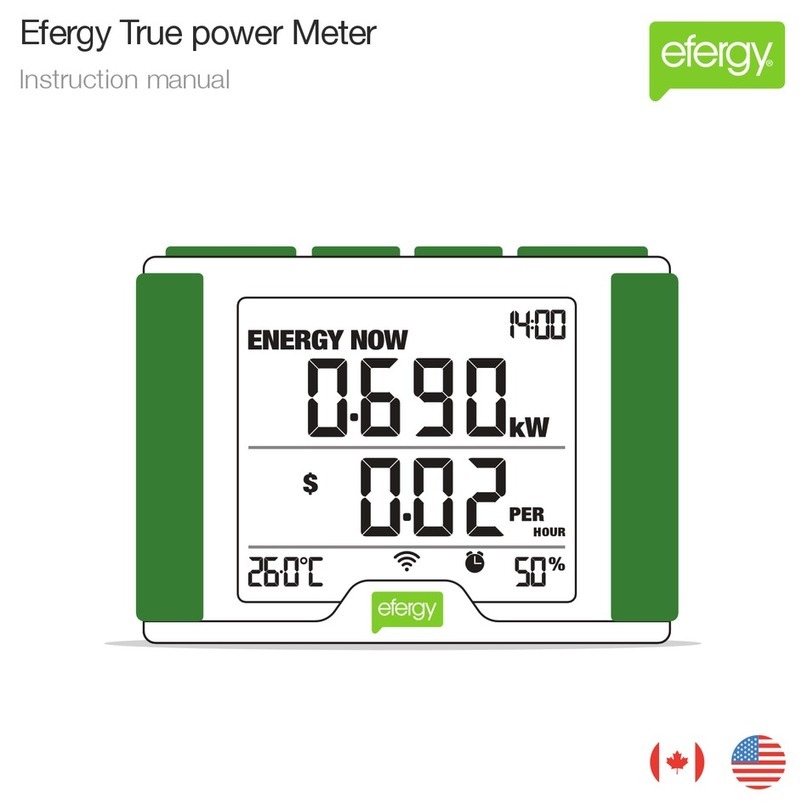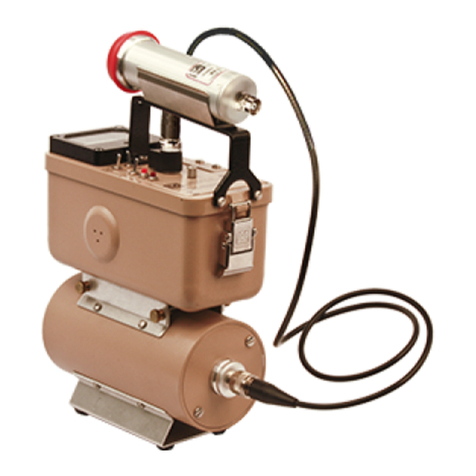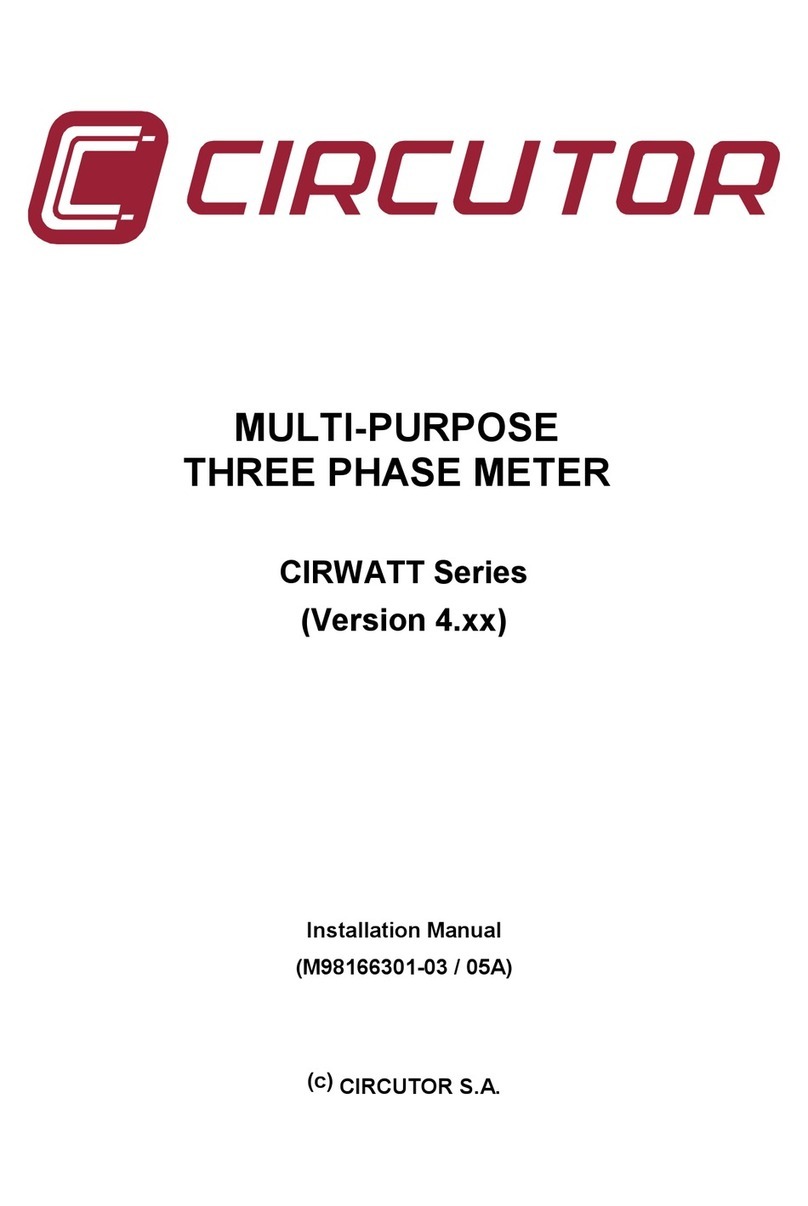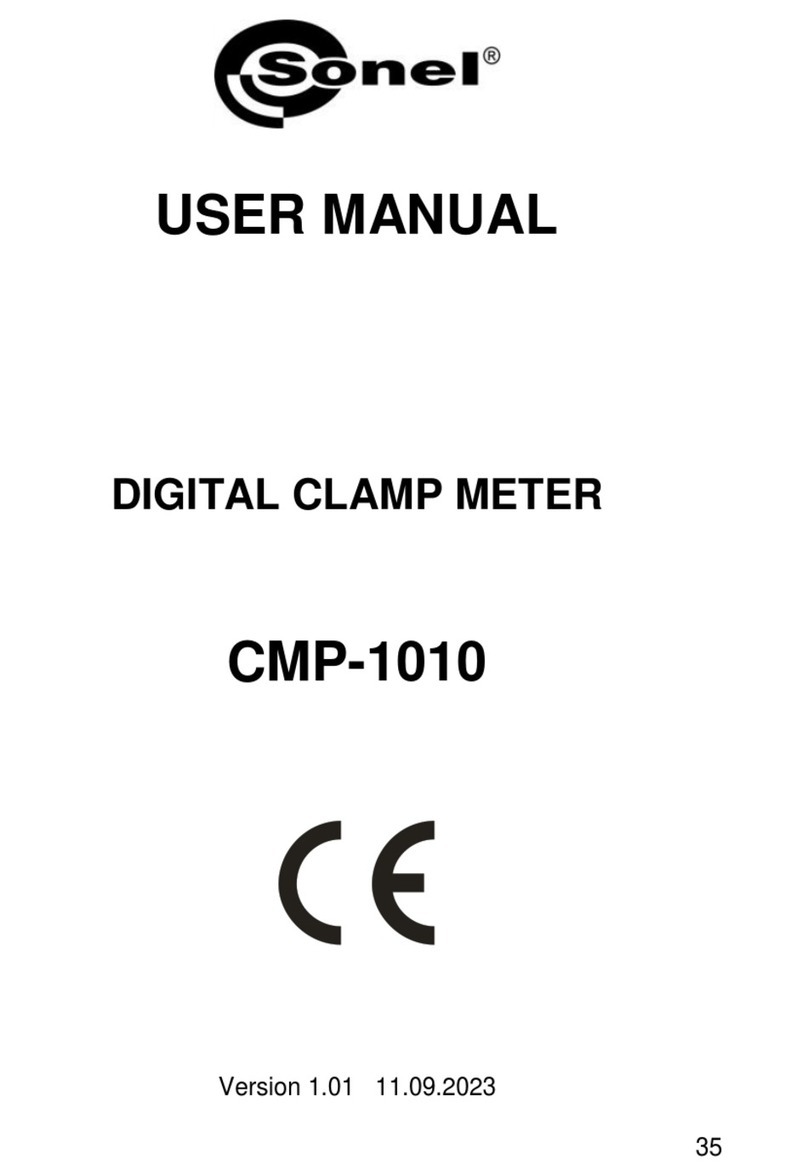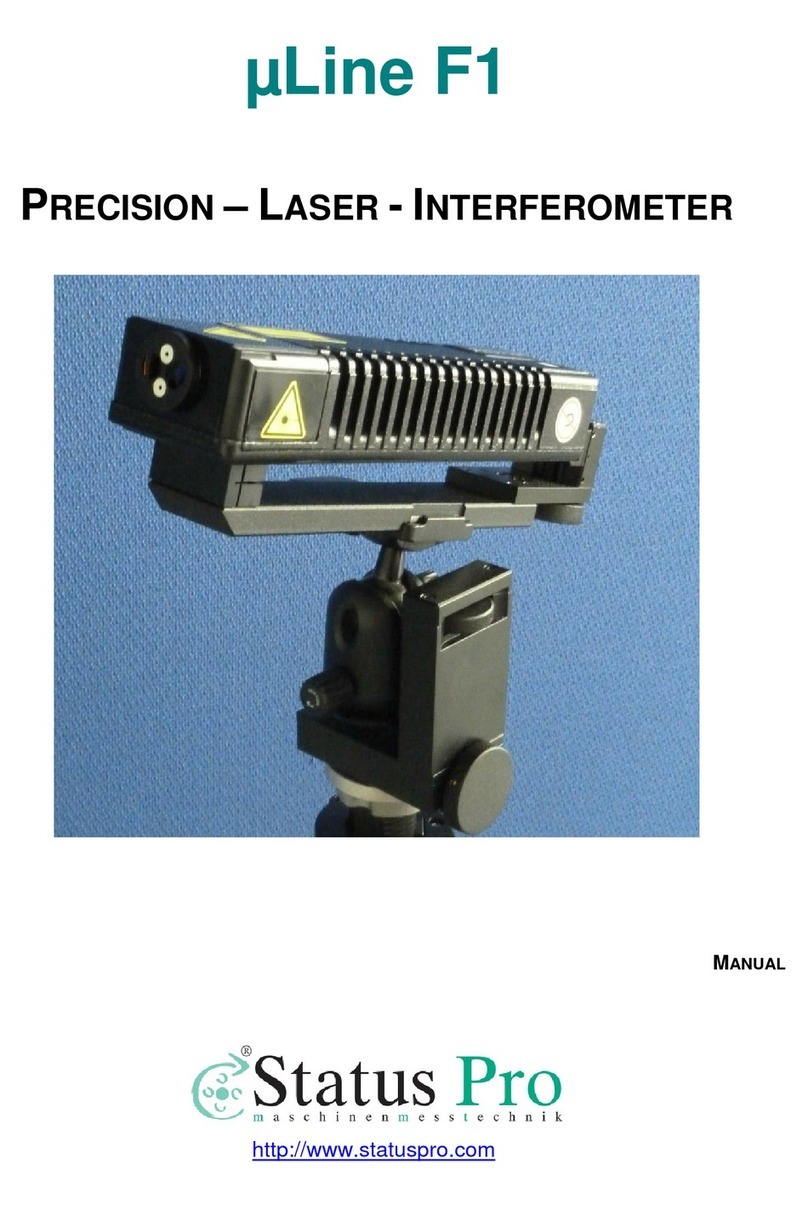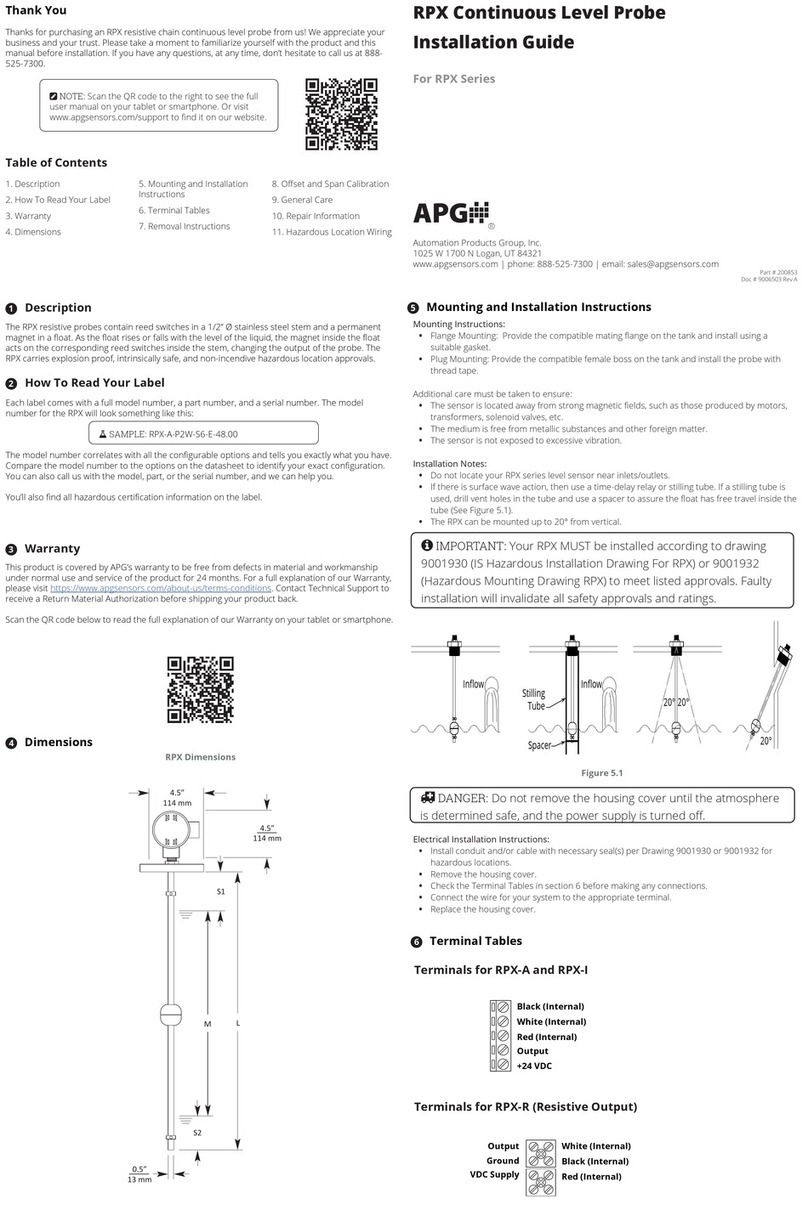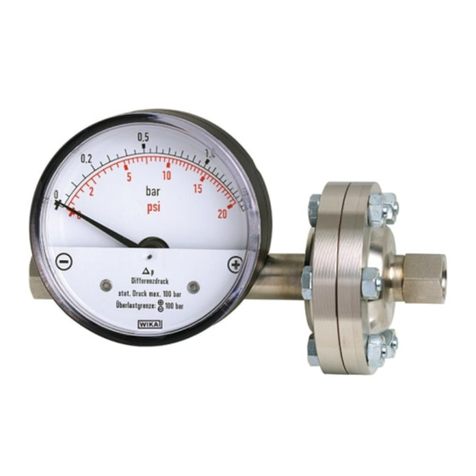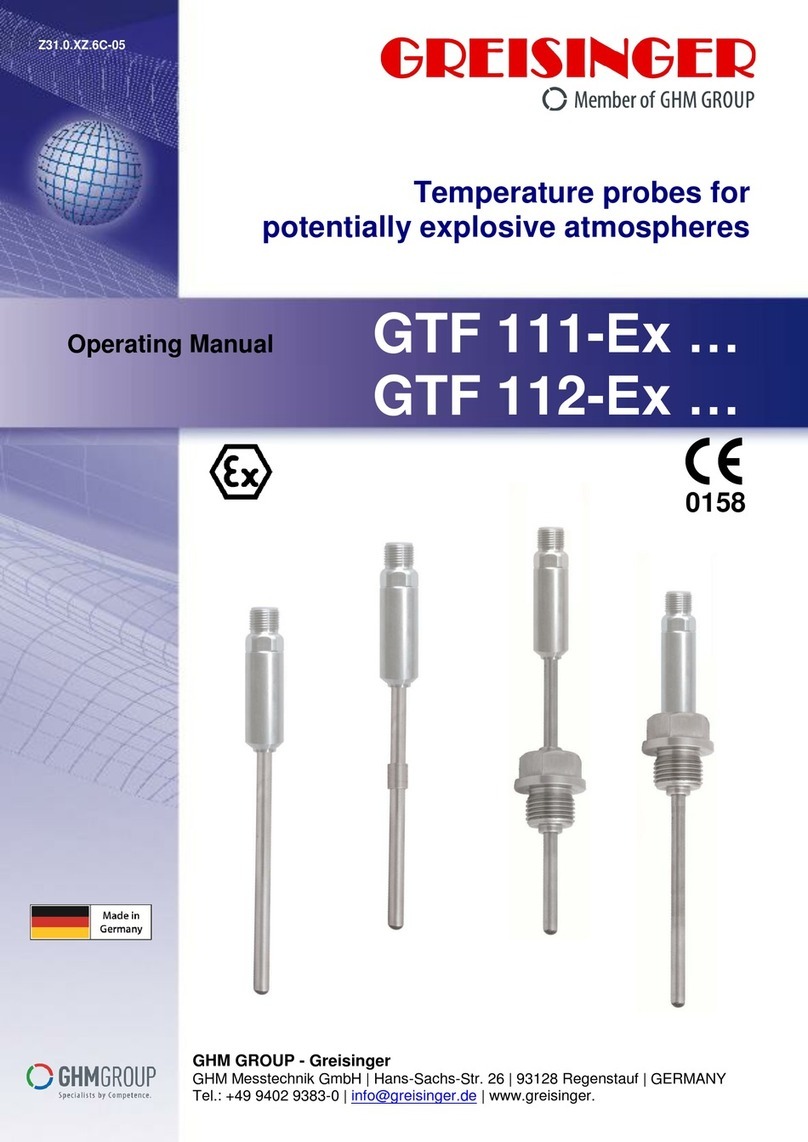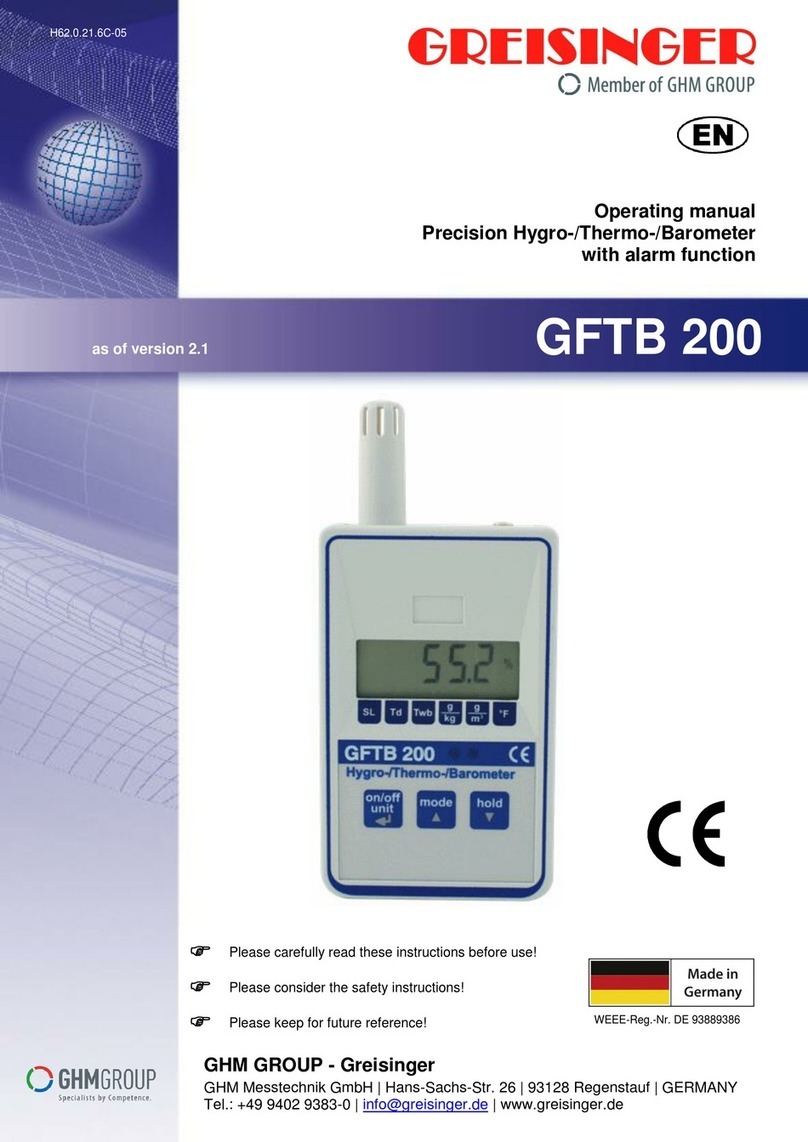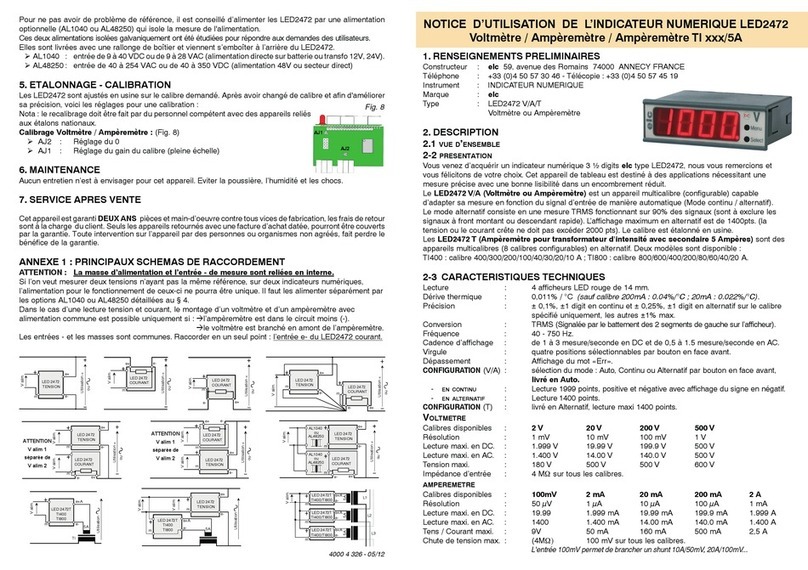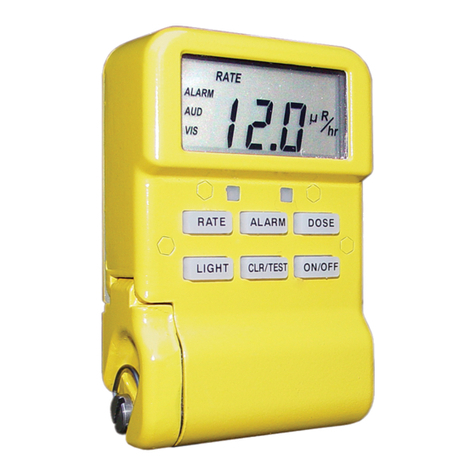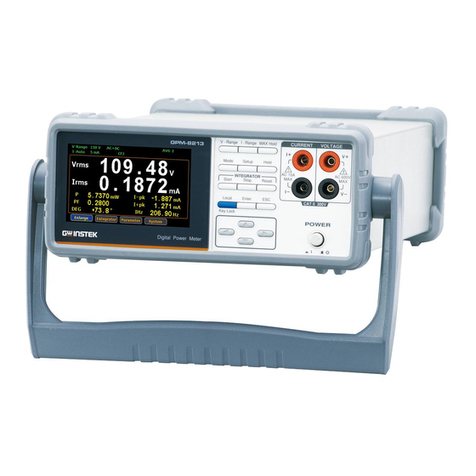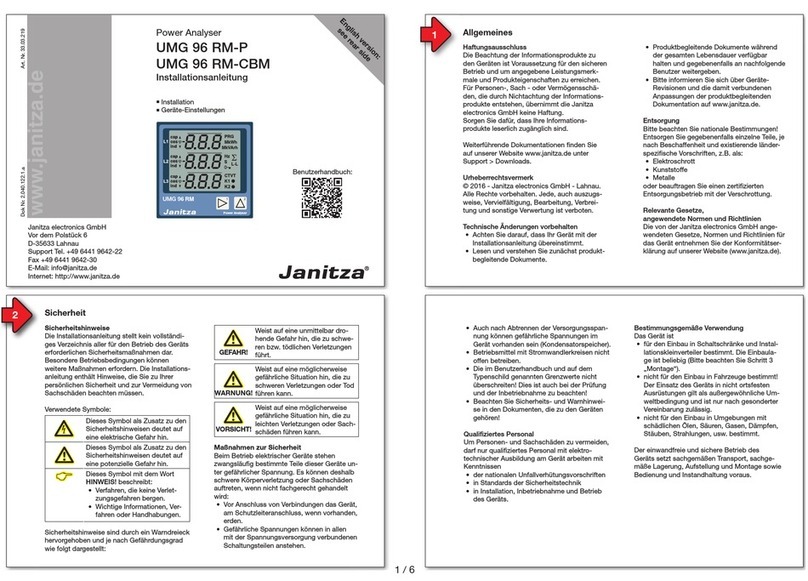ELECTROMATIC TI-25M-MMX User manual

– 1 –
TABLE OF CONTENTS
01.0 Introduction. . . . . . . . . . . . . . . . . . . . . . . . . . . . . . . . . . . . . . . . . . . . 02
02.0 Precautions. . . . . . . . . . . . . . . . . . . . . . . . . . . . . . . . . . . . . . . . . . . . 02
03.0 Overview . . . . . . . . . . . . . . . . . . . . . . . . . . . . . . . . . . . . . . . . . . . . . . 03
3.1 Gauge
3.2 Contents of Kit
3.3 Probe
3.4 Keypad
3.5 LCD Display
3.6 Probe Zero Plate
3.7 Probe Connector Receptacle
3.8 Battery Compartment (Charging the Battery)
04.0 Making Measurements. . . . . . . . . . . . . . . . . . . . . . . . . . . . . . . . . . 09
4.1 Condition and Preparation of Surfaces
4.2 Probe Zero
4.3 Calibration
05.0 Quick Start Instructions . . . . . . . . . . . . . . . . . . . . . . . . . . . . . . . . 14
06.0 Scan Mode. . . . . . . . . . . . . . . . . . . . . . . . . . . . . . . . . . . . . . . . . . . . . 15
07.0 Alarm Mode . . . . . . . . . . . . . . . . . . . . . . . . . . . . . . . . . . . . . . . . . . . . 16
08.0 Dual-Multi Mode. . . . . . . . . . . . . . . . . . . . . . . . . . . . . . . . . . . . . . . . 17
09.0 RS 232 Serial Port. . . . . . . . . . . . . . . . . . . . . . . . . . . . . . . . . . . . . . 18
10.0 Transducer Selection . . . . . . . . . . . . . . . . . . . . . . . . . . . . . . . . . . . 19
10.1 Initial Signal Strength
10.2 Absorption and Scattering
10.3 Geometry of the Transducer
10.4 Temperature of the Material
10.5 Through Paint and Coatings
11.0 Calibrations for MeasuringThickness
of Materials Other Than Steel . . . . . . . . . . . . . . . . . . . . . . . . . . . 21
11.1 Changing Acoustic Velocity
11.2 Acoustic Velocity Table
12.0 Specifications. . . . . . . . . . . . . . . . . . . . . . . . . . . . . . . . . . . . . . . . . . 24
13.0 Material Safety Data . . . . . . . . . . . . . . . . . . . . . . . . . . . . . . . . . . . . 25
14.0 Application Notes . . . . . . . . . . . . . . . . . . . . . . . . . . . . . . . . . . . . . . 26
13.1 Measuring Pipe and Tubing
13.2 Measuring Hot Surfaces
13.3 Measuring Laminated Materials
13.4 Measuring Through Paint and Coatings
15.0 Warranty. . . . . . . . . . . . . . . . . . . . . . . . . . . . . . . . . . . . . . . . . . . . . . . 28
– 28 –
14.0 WARRANTY
ELECTROMATIC Equipment Co., Inc. (ELECTROMATIC) warrants to the
original purchaser that this product is of merchantable quality and confirms
in kind and quality with the descriptions and specifications thereof. Product
failure or malfunction arising out of any defect in workmanship or material in the
product existing at the time of delivery thereof which manifests itself within one
year from the sale of such product, shall be remedied by repair or replacement of
such product, at ELECTROMATIC’s option, except where unauthorized repair,
disassembly, tampering, abuse or misapplication has taken place, as determined
by ELECTROMATIC. All returns for warranty or non-warranty repairs and/or
replacement must be authorized by ELECTROMATIC, in advance, with all
repacking and shipping expenses to the address below to be borne by the
purchaser.
THE FOREGOING WARRANTY IS IN LIEU OF ALL OTHER
WARRANTIES, EXPRESSED OR IMPLIED, INCLUDING BUT NOT
LIMITED TO, THE WARRANTY OF MERCHANTABILITY AND FITNESS
FOR ANY PARTICULAR PURPOSE OR APPLICATION. ELECTROMATIC
SHALL NOT BE RESPONSIBLE NOR LIABLE FOR ANY CONSEQUEN-
TIAL DAMAGE, OF ANY KIND OR NATURE, RESULTING FROM THE
USE OF SUPPLIED EQUIPMENT, WHETHER SUCH DAMAGE OCCURS
OR IS DISCOVERED BEFORE, UPON OR AFTER REPLACEMENT OR
REPAIR, AND WHETHER OR NOT SUCH DAMAGE IS CAUSED BY
MANUFACTURER’S OR SUPPLIER’S NEGLIGENCE WITHIN ONE YEAR
FROM INVOICE DATE.
Some State jurisdictions or States do not allow the exclusion or limitation of inci-
dental or consequential damages, so the above limitation may not apply to you.
The duration of any implied warranty, including, without limitation, fitness for
any particular purpose and merchantability with respect to this product, is limited
to the duration of the foregoing warranty. Some states do not allow limitations on
how long an implied warranty lasts but, not withstanding, this warranty, in the
absence of such limitations, shall extend for one year from the date of invoice.
ELECTROMATIC Equipment Co., Inc.
600 Oakland Ave. Cedarhurst, NY 11516—USA
Tel: 1-800-645-4330/ Tel: 516-295-4300/ Fax: 516-295-4399
Every precaution has been taken in the preparation of this manual. Electromatic Equipment Co., Inc.,
assumes no responsibility for errors or omissions. Neither is any liability assumed for damages resulting
from the use of information contained herein. Any brand or product names mentioned herein are used for
identification purposes only, and are trademarks or registered trademarks of their respective holders.

– 2 –
1.0 INTRODUCTION
The TI-25M-MMX is a multi-mode Ultrasonic thickness gauge that is capable of
measuring the thickness of various materials with accuracy as high as ± 0.001
inches, or ± 0.01 millimeters. The principle advantage of ultrasonic measurement
over traditional methods is that ultrasonic measurements can be performed with
access to only one side of the material being measured. The multi-mode feature
of the TI-25M-MMX allows the user to toggle between pulse-echo mode (flaw
and pit detection), and echo-echo mode (eliminate paint or coating thickness).
2.0 PRECAUTIONS
Do not use the standard probe in applications where material temperatures exceed
200 °F (100 °C) as the probe will be damaged. Special High Temperature Probes
should be used. Consult factory.
Keep the gauge free of dust (especially metal powders, carbon, etc.) as they will
damage the gauge. Use a damp cloth to clean the gauge after use.
DO NOT USE CHEMICAL SOLVENTS OF ANY KIND.
– 27 –
13.3 Measuring laminated materials
Laminated materials are unique in that their density (and therefore sound-veloci-
ty) may vary considerably from one piece to another. Some laminated materials
may even exhibit noticeable changes in sound-velocity across a single surface.
The only way to reliably measure such materials is by performing a calibration
procedure on a sample piece of known thickness. Ideally, this sample material
should be a part of the same piece being measured, or at least from the same lam-
ination batch. By calibrating to each test piece individually, the effects of varia-
tion of sound-velocity will be minimized.
An additional important consideration when measuring laminates, is that any
included air gaps or pockets will cause an early reflection of the ultrasound beam.
This effect will be noticed as a sudden decrease in thickness in an otherwise regu-
lar surface. While this may impede accurate measurement of total material thick-
ness, it does provide the user with positive indication of air gaps in the laminate.
13.4 Measuring Through Paint & Coatings
Measuring through paints and coatings are also unique, in that the velocity of the
paint / coating will be significantly different from the actual material being meas-
ured. A perfect example of this would be a mild steel pipe with approximately
.025” of coating on the surface. Where the velocity of the pipe is .2330 in/msec,
and the velocity of the paint is .0900 in/msec. If the user is calibrated for mild
steel pipe and measures through both materials, the actual coating thickness will
appear to be 2.5 times thicker than it actually is, as a result of the differences in
velocity. This error can be eliminated by using a special echo-echo mode to
perform measurements for applications such as these. In echo-echo mode, the
paint/coating thickness will be eliminated entirely and the steel will be the only
material measured.

– 3 –
3.0 OVERVIEW OFGAUGE
3.1 Gauge
Probe
Receptacles
Probe Zero Test Plate and
Battery Compartment Cover
Backlit LCD
Display
Membrane
Keypad
Probe
–26 –
13.0 APPLICATION NOTES
13.1 Measuring pipe and tubing
When measuring a piece of pipe to determine the thickness of the pipe wall, ori-
entation of the transducers is important. If the diameter of the pipe is larger than
approximately 4 inches, measurements should be made with the transducer orient-
ed so that the gap in the wearface is perpendicular (at right angle) to the long axis
of the pipe. For smaller pipe diameters, two measurements should be performed,
one with the wearface gap perpendicular, another with the gap parallel to the long
axis of the pipe. The smaller of the two displayed values should then be taken as
the thickness at that point.
13.2 Measuring hot surfaces
The velocity of sound through a substance is dependent upon its temperature.
As materials heat up, the velocity of sound through them decreases. In most
applications with surface temperatures less than about 200 °F (100 °C), no
special procedures must be observed. At temperatures above this point, the
change in sound velocity of the material being measured starts to have a
noticeable effect upon ultrasonic measurement.
At such elevated temperatures, it is recommended that the user perform a
calibration procedure (refer to page 11) on a sample piece of known thickness,
which is at or near the temperature of the material to be measured. This will
allow the TI-25M-MMX to correctly calculate the velocity of sound through the
hot material.
When performing measurements on hot surfaces, it may also be necessary to use
a specially constructed high-temperature transducer. These transducers are built
using materials which can withstand high temperatures. Even so, it is recom-
mended that the probe be left in contact with the surface for as short a time as
needed to acquire a stable measurement. While the transducer is in contact with
a hot surface, it will begin to heat up, and through thermal expansion and other
effects, may begin to adversely affect the accuracy of measurements.
ABParallel
Perpendicular

– 4 –
3.2 Contents Of Kit
The TI-25M-MMX is supplied as a complete kit with the following:
a. Gauge
b. Two (2) AA batteries
(installed in gauge)
c. Probe/cable assembly
d. 4 oz. Bottle of coupling fluid
e. NIST-traceable calibration
certificate
f. Operating instruction manual
g. Foam-filled carrying case
3.3 Probe
The probe transmits and receives the ultrasonic sound waves which the
TI-25M-MMX uses to calculate the thickness of the material being meas-
ured. The probe must be used correctly in order for the TI-25M-MMX to
produce accurate and reliable results.
A small amount of “coupling” fluid, commonly called “couplant” is used to
insure that there are no air gaps between the probe and the material surface.
Grasp the probe by the molded rubber grip and place it on top of the mate-
rial surface. Apply moderate pressure to the top surface of the probe with
your index finger (A) or thumb (B) to stabilize the probe and to keep the
wearface seated flat against the measurement surface.
ad
c
e
g
Probe
Wearface
AB
– 25 –
12.0 MATERIAL SAFETY DATA SHEET (MSDA)
Section 1— Product Identification
Product Name: TI-25M Generic Name: Ultrasonic Couplant
Manufacturer: Electromatic Equipt. Co. NFPA Hazardous Materials Identification System (est)
Health 0 Flammability 0 Reactivity 0
Section 2— Hazardous Ingredients
This material does not contain any ingredients having known health hazards in concentrations
greater than 1%. This material does not contain any known or suspected carcinogens.
Section 3 — Physical Data (nominal)
Boiling Point: >220°F Freezing Point: <20°F
Vapor Pressure: N/A Evaporation Rate: N/A
Specific Gravity: >1.0Z Solubility in Water: complete
pH: 7.35 – 7.9 Acoustic Imp.: 1.726x106
Vapor Density: N/A Appearance and Odor: water white, opaque gel; bland odor
Section 4 — Fire and Explosive Hazard Data
Flash Point: none Upper Exposure Limit: none Lower Exposure Limit: none
Special Fire Fighting Procedures: N/A Extinguishing media: N/A
Unusual Fire and Explosion Hazards: none
Section 5 — Reactive Data
Stability: Stable Conditions to Avoid: none
Incompatibility (Materials to Avoid): none known
Hazardous Polymerization: will not occur
Hazardous Decomposition or Byproducts: none known
Section 6 —- Health Hazard and First Aid Data
Routes of Entry1:
Skin: not likely Ingestion: not normally Eyes: not normally Inhalation: no
Effects of Overexposure:
Acute: May cause temporary eye irritation Chronic: none expected
First Aid Procedures:
Skin: Remove with water if desired. Eyes: Flush with water for 15 minutes.
Ingestion: For large quantities, induce vomiting and call a physician Inhalation: N/A
Section 7 - Storage and Handling Information
Precautions to be taken in handling and storage: Store between 20 °F and 120 °F. Spills are
slippery and should be cleaned up immediately. Steps to be taken in case material is released or
spilled: Pick up excess for disposal. Clean with water. Waste disposal method: Dispose of in
accordance with federal, state, and local regulations.
Section 8 — Control Measures
Respiratory Protection: not required Ventilation: not required
Protective Gloves: on individuals demonstrating sensitivity to TI-25M
Eye Protection: as required by working conditions Other Protective Equipment: not required
1. TI-25M-MMX contains only food grade and cosmetic grade ingredients.

– 5 –
3.4 The Keypad
The TI-25M-MMX interacts with the operator through the
membrane keypad and the LCD display. The functions of
the various keys on the keypad are detailed below, followed
by an explanation of the display and its various symbols.
This key is used to turn the TI-25M-MMX on and off. When the
gauge is turned ON, it will first perform a brief display test by
illuminating all of the segments in the display. After one second,
the gauge will display the internal software version number. After
displaying the version number, the display will show “0.000” (or
“0.00” if using metric units), indicating the gauge is ready for use.
The TI-25M-MMX is turned OFF by pressing the ON/OFF key.
The gauge has a special memory that retains all of its settings even
when the power is off. The gauge also features an auto-power
down mode designed to conserve battery life. If the gauge is idle
for 5 minutes, it will turn itself off.
The PRB-0 key is used to “zero” the TI-25M-MMX in much the
same way that a mechanical micrometer is zeroed. If the gauge is
not zeroed correctly, all of the measurements that the gauge makes
may be in error by some fixed value. Refer to page 10 for an
explanation of this important procedure.
The CAL key is used to enter and exit the TI-25M-MMX’s
calibration mode. This mode is used to adjust the sound-velocity
value that the TI-25M-MMX will use when calculating thickness.
The gauge will either calculate the sound-velocity from a sample
of the material being measured, or allow a known velocity value to
be entered directly. Refer to page 11 for an explanation of the two
CAL functions available.
The IN/MM key is used to switch back and forth between English
and metric units. This key may be used at any time, whether the
gauge is displaying a thickness (IN or MM) or a velocity value
(IN/ms or M/s).
The UP arrow key has two functions. When the TI-25M-MMX is
in calibration mode, this key is used to increase numeric values on
the display. An auto-repeat function is built in, so that when the
key is held down, numeric values will increment at an increasing
rate. When the TI-25M-MMX is not in calibration mode, the UP
arrow key switches the SCAN measurement mode on and off.
Refer to page 15 for an explanation of the SCAN measurement
mode.
ALRM
ON
OFF
IN
MM
DUAL
MULTI
PRB
SEND
CAL
SCAN
0
ON
OFF
PROBE
ZERO
CAL
INCH
MM
SCAN
– 24 –
11.0 SPECIFICATIONS
Range
TI-25M-MMX* Pulse-Echo Mode (Pit & Flaw Detection):
0.040–6.000" (1.01–152 mm)
Echo-Echo Mode (Through Paint & Coatings):
0.100–1.0" (2.54–25.4 mm). With up to 0.040" of coating.
TI-25M-MMX-EXT* Pulse-Echo Mode (Pit & Flaw Detection):
0.100–10.000" (2.54–254 mm)
Echo-Echo Mode (Through Paint & Coatings):
0.200–5.0" (5–127 mm). With up to 0.080" of coating.
Resolution .001" (0.01 mm)
Display 41⁄2-Digit, 0.5" Backlit LCD
Velocity Range 0.0492 to .3937 in./µs. (1250 to 10,000 meters/second)
Probe
TI-25M-MMX 5 MHz, 0.25" Dia. (6.35 mm), High Damp
TI-25M-MMX-EXT 3.5 MHz, 0.5" Dia. (12.70 mm), High Damp
Probe Wearface PEEK (Polyethylethylkeytone)
Cable 4 ft. (1.2 m) waterproof cable with non-polarized,
quick-disconnect connectors.Optional lengths up to
100 ft. (30 m).
Probe Zero Steel plate built into battery cover, appriximate thickness
Test Plate of 0.416" (10.57mm)
Temp. Limits Ambient: –20 to 120 °F (–30 to 50 °C)
Material: 0 to 200 °F (–20 to 100 °C)
Special high temperature probes are optionally available.
Battery Type Two AA batteries
Battery Life 200 hours
Weight 7 ounces (196 g)
Size 2.4 x 4.5 x 1.25" (65 x 114 x 35 mm)
Accessories
Included Probe/cable assembly. 4oz. bottle of coupling fluid,
NIST Calibration Certificate, 2 AA batteries, operating
instructions,hard-plastic carrying case.
Warranty Gauge: 5 years
Probe: 90 days
*Measuring Range indicated is for steel. Actual range for other materials will
vary based upon the material’s sonic velocity and attenuation.

– 6 –
The DOWN arrow key has two functions. When the
TI-25M-MMX is in the CAL mode, this key is used to decrease
numeric values on the display. An auto-repeat function is built in,
so that when the key is held down, numeric values will decrement
at an increasing rate. When the TI-25M-MMX is not in calibration
mode, the DOWN arrow key switches the display backlight
between three available settings. OFF will be displayed when the
backlight is switched off. AUTO will be displayed when the back
light is set to automatic mode, and ON will be displayed when the
backlight is set to stay on. In the AUTO setting, the backlight will
illuminate while the TI-25M-MMX is making a measurement and
turn off after several seconds to conserve battery life.
The ALRM key has two functions. By holding down the ALRM
key when powering up the TI-25M-MMX, the audible beeper will
be turned on or off accordingly. After the unit has been turned on,
pressing the ALRM key will toggle the alarm mode to the on/off
positions and allow the user to enter a nominal thickness value.
Refer to page 18 for details on how to use the alarm feature.
The DUAL-MULTI key is used to toggle pulse-echo ( flaw & pit
detection), and echo-echo ( eliminate paint & coating thickness ).
This enables the user to very conveniently switch between modes
depending on application requirements. Refer to page 17 for a
complete explanation of this feature.
The SEND key is used to send the currently displayed
thickness measurement to an external storage device via the
TI-25M-MMX’s RS232 port. Refer to page 18 for an explanation
of how to use this feature
3.5 LCD Display
The numeric portion of the display consists four
complete digits preceded by a leading “1”, and
is used to display numeric values, as well as
occasional simple words, to indicate the status of
various settings. When the TI-25M-MMX is displaying thickness measure-
ments, the display will hold the last value measured, until a new measure-
ment is made. Additionally, when the battery voltage is low, the entire dis-
play will begin to flash. When this occurs, the batteries should be replaced.
These eight vertical bars form the Stability
Indicator. When the TI-25M-MMX is idle, only
the left-most bar and the underline will be on.
While the gauge is taking a measurement, six or
seven of the bars should be on. If fewer than five bars are on, the
TI-25M-MMX is having difficulty achieving a stable measurement, and
the thickness value displayed will most likely be erroneous.
1.8.8.8.8
+INMM/µs
ALRM
SEND
DUAL
MULTI
1.8.8.8.8
+INMM/µs
– 23–
11.2 Acoustic Velocity Table
Aluminum 0.2500 6350
Bismuth 0.8600 2184
Brass 0.1730 4394
Cadmium 0.1090 2769
Cast Iron 0.18000 4572
Constantan 0.2060 5232
Copper 0.1840 4674
Epoxy resin 0.1000 2540
German silver 0.1870 4750
Glass, crown 0.2230 5664
Glass, flint 0.1680 4267
Gold 0.1280 3251
Ice 0.1570 3988
Iron 0.2320 5898
Lead 0.8500 2159
Magnesium 0.2280 5791
Nickel 0.2220 5639
Nylon 0.1020 2591
Paraffin 0.0870 2210
Platinum 0.1560 3962
Plexiglass 0.1060 2692
Polystyrene 0.0920 2337
Porcelain 0.2300 5842
PVC 0.0940 2388
Quartz glass 0.2220 5639
Rubber, vulcanized 0.0910 2311
Silver 0.1420 3607
Steel, common 0.2330 5920
Steel, stainless 0.2230 5664
Stellite 0.2750 6985
Tin 0.1310 3327
Titanium 0.2400 6096
Tungsten 0.2100 5334
Zinc 0.1660 4216
Material Velocity Velocity
Type Inches/µs Meters/s
Notes: 1. These values are to be used only when a suitable sample of known thick-
ness is not available for calibrating, as slight variations in material
composition, finishing (hardening, polishing, etc.) or shape can affect the
acoustic velocity. ...
Notes: 2. “✔”denotes the factory default setting for acoustic velocity.
✔

– 7 –
When the IN symbol is on, the TI-25M-MMX is
displaying a thickness value in inches. The
maximum thickness that can be displayed is
19.999 inches.
When the MM symbol is on, the TI-25M-MMX
is displaying a thickness value in millimeters. If
the displayed thickness exceeds 199.99 millime-
ters, the decimal point will shift automatically to
the right, allowing values up to 1999.9 millime-
ters to be displayed.
When the IN symbol is on, in conjunction
with the /µs symbol, the TI-25M-MMX is
displaying a sound-velocity value in inches-
per-microsecond.
When the Msymbol is on, in conjunction with
the /s symbol, the TI-25M-MMX is displaying
a sound-velocity value in meters-per-second.
When the + symbol is on and blinking, this indi-
cates that the TI-25M-MMX is currently operat-
ing in echo-echo ( Thru-paint/coating ) mode.
3.6 Probe Zero Plate
When first connecting the probe supplied with the TI-25M-MMX, the user
should perform a “Probe Zero” as described in Section 4.2. The Probe Zero
Test Plate is used for this task. It is located on the top edge of the gauge as
shown in the photo below. It also serves as the battery compartment cover
Note: The thickness of this plate is not important, and it should not be
used as a Calibration Test Plate. A precision 4-step Test Block is optionally
available for this purpose.
1.8.8.8.8
+INMM/µs
1.8.8.8.8
+INMM/µs
1.8.8.8.8
+INMM/µs
1.8.8.8.8
+INMM/µs
1.8.8.8.8
+INMM/µs
– 22 –
7. Press the CAL key again and the acoustic velocity units indicator
“IN/µs” or“M/s” will be flashing showing the acoustic velocity
value that was calculated for this sample. If desired, record this
value so it can be re-entered easily in the future.
8. Press the CAL key again to exit the calibration mode and return to
the measurement mode.
Note: If the CAL key is pressed while in the calibration mode, the
TI-25M-MMX will be reset to the factory default calibration for common
steel (0.2330 IN/µs or 5920 M/s).

– 8 –
3.7 Probe Connector Receptacle
Located on the top edge of the TI-25M-MMX housing are the receptacles
for the probe and the probe zero plate.
The connectors for the probe
are non-polarized so the con-
nector at the end of the probe
cable can be inserted into
this receptacle in either
orientation. Make sure the
connector is “well seated” in
the receptacle.
3.8 Battery Compartment (Changing The Battery)
The battery compartment is
located under the probe zero
test plate. To open the battery
compartment, unscrew the
probe zero plate by rotating it
counterclockwise. The
TI-25M-MMX operates on
two (2) AA Batteries (1.5 V).
If desired, rechargeable
batteries may be used.
The TI-25M-MMX is shipped with the batteries installed. Insert batteries in
the polarity indicated on the rear label.
Note: When the display elements begin to flash off and on repeatedly, the
batteries are low and should be replaced.
Battery Cover
Probe Receptacles
Probe Zero
Plate
– 21 –
11.0 CALIBRATION FOR MEASURING THICKNESS OF
MATERIALS OTHER THAN STEEL
Ultrasonic Thickness Gauges use sound waves to measure wall thickness.
Different types of materials have different inherent acoustic velocities. For
instance, the acoustic velocity of steel is 0.2330 IN/µs (inches-per-microsecond),
versus that of aluminum, which is about 0.2500 IN/µs. It is critical that the
TI-25M-MMX be set for the correct acoustic velocity depending upon the materi-
al to be measured.
The TI-25M-MMX is shipped from the factory calibrated for steel with an
acoustic velocity of 0.2330 IN/µs (5920 M/s). To measure the thickness of any
other material, the calibration will have to be changed by adjusting the acoustic
velocity to the appropriate value for the specific material being measured.
To determine the proper acoustic velocity for the non-steel material, refer to the
Acoustic Velocity Table, section 10.1. After determining the proper acoustic
velocity, the gauge must be re-calibrated for this new value.
If you do not know the type of material to be measured or if the material type is
not listed in the Acoustic Velocity Table follow the following procedure.
11.1 Changing Calibration - Acoustic Velocity Is Not Known
In applications where the type of material is not known or the material is
not listed in the Acoustic Velocity Table, the following procedure can be
used to calibrate the gauge for highest accuracy.
1. Obtain a sample of the material with a known thickness or use a
micrometer, caliper or similar device to accurately measure it.
2. Turn on the gauge by pressing the ON/OFF key.
3. Place a small amount of coupling fluid on the sample of known
thickness and place the probe on the sample. The Stability Indicator
should have nearly all its bars illuminated. Having achieved a stable
reading remove the probe from the sample.
4. Press the CAL key.
5. The units of measure indicator “IN” or “MM” will be flashing
indicating that you are in the Measurement Calibration mode.
6. Use the UP and DOWN arrow keys to adjust the displayed measurement
value to match the thickness of the known sample. By pressing and
holding the key, the numbers will change more rapidly.

– 9 –
4.0 MAKING MEASUREMENTS
In order for the transducer to do its job, there must be no air gaps between the
wear-face and the surface of the material being measured. This is accomplished
with the use of a “coupling” fluid, commonly called “couplant”. This fluid serves
to “couple”, or transfer, the ultrasonic sound waves from the transducer, into the
material, and back again. Before attempting to make a measurement, a small
amount of couplant should be applied to the surface of the material being meas-
ured. Typically, a single droplet of couplant is sufficient.
After applying couplant, press the transducer (wearface down) firmly against the
area to be measured. The Stability Indicator should have six or seven bars dark-
ened, and a number should appear in the display. If the TI-25M-MMX has been
properly “zeroed” (see page 10) and set to the correct sound velocity (see page
11), the number in the display will indicate the actual thickness of the material
directly beneath the transducer.
If the Stability Indicator has fewer than five bars darkened, or the numbers on the
display seem erratic, first check to make sure that there is an adequate film of
couplant beneath the transducer, and that the transducer is seated flat against the
material. If the condition persists, it may be necessary to select a different trans-
ducer (size or frequency) for the material being measured. See page 22.
While the transducer is in contact with the material that is being measured, the
TI-25M-MMX will perform four measurements every second, updating its display
as it does so. When the transducer is removed from the surface, the display will
hold the last measurement made.
IMPORTANT
Occasionally, a small film of couplant will be drawn out between the
transducer and the surface as the transducer is removed. When this
happens, the TI-25M-MMX may perform a measurement through this
couplant film, resulting in a measurement that is larger or smaller than
it should be. This phenomenon is obvious when one thickness value is
observed while the transducer is in place, and another value is observed
after the transducer is removed.
In addition, measurements through very thick paint or coatings may result
in the paint or coating being measured rather than the actual material
intended. The responsibility for proper use of the instrument, and recognition
of these types of phenomenon’s, rest solely with the user of the instrument.
– 20 –
10.4 Temperature of the Material
When it is necessary to measure on surfaces that are exceedingly hot, high tem-
perature transducers must be used. These transducers are built using special mate-
rials and techniques that allow them to withstand high temperatures without dam-
age. Additionally, care must be taken when performing a “Probe-Zero” or
“Calibration to Known Thickness” with a high temperature transducer. See
Application Notes for more information on measuring materials with a high
temperature transducer.
Selection of the proper transducer is often a matter of tradeoffs between various
characteristics. It may be necessary to experiment with a variety of transducers
in order to find one that works well for a given job. Electromatic can
provide assistance in choosing a transducer, and offers a broad selection of
transducers for evaluation in specialized applications.
10.5 Through Paint & Coatings
The TI-25M-MMX has the ability to measure through and eliminate the thickness
of paint or coatings on the surface of metals. While this is a very convenient fea-
ture, it must be used with the proper transducers in order to produce favorable
results. Special high damped alpha style transducers must be used in order to
achieve optimal results. Consult Dakota Ultrasonics directly for assistance in
choosing the proper transducer for use with the Multi-Mode feature.

– 10 –
4.1 Condition and Preparation of Surfaces
In any ultrasonic measurement scenario, the shape and roughness of the test sur-
face are of paramount importance. Rough, uneven surfaces may limit the penetra-
tion of ultrasound through the material, and result in unstable, and therefore unre-
liable, measurements. The surface being measured should be clean, and free of
any small particulate matter, rust, or scale. The presence of such obstructions will
prevent the transducer from seating properly against the surface. Often, a wire
brush or scraper will be helpful in cleaning surfaces. In more extreme cases,
rotary sanders or grinding wheels may be used, though care must be taken to pre-
vent surface gouging, which will inhibit proper transducer coupling.
Extremely rough surfaces, such as the pebble-like finish of some cast iron, will
prove most difficult to measure. These kinds of surfaces act on the sound beam
like frosted glass on light:, the beam becomes diffused and scattered in all direc-
tions.
In addition to posing obstacles to measurement, rough surfaces contribute to
excessive wear of the transducer, particularly in situations where the transducer is
“scrubbed” along the surface. Transducers should be inspected on a regular basis,
for signs of uneven wear of the wearface. If the wearface is worn on one side
more than another, the sound beam penetrating the test material may no longer be
perpendicular to the material surface. In this case, it will be difficult to exactly
locate tiny irregularities in the material being measured, as the focus of the sound-
beam no longer lies directly beneath the transducer.
4.2 Probe Zero
Setting the Zero Point of the TI-25M-MMX is important for the same reason that
setting the zero on a mechanical micrometer is important. If the gauge is not
“zeroed” correctly, all of the measurements the gauge makes will be in error by
some fixed number. When the TI-25M-MMX is “zeroed”, this fixed error value is
measured and automatically corrected for in all subsequent measurements. The
TI-25M-MMX may be “zeroed” by performing the following procedure:
Performing a Probe-Zero
1. Make sure the TI-25M-MMX is on.
2. Plug the transducer into the TI-25M-MMX. Make sure that the connectors
are fully engaged. Check that the wearface of the transducer is clean and free
of any debris.
3. The metal probe-disc is on the top end of the TI-25M-MMX. Apply a single
droplet of ultrasonic couplant to the face of this disc.
4. Make sure that the TI-25M-MMX is in P-E ( pulse-echo mode) by pressing the
Dual-Multi key to toggle the modes.
Note: The Probe-Zero feature is not used in Echo-Echo Thru-Paint mode, and
has been disabled. If the PRB-0 key is pressed, while in this mode, “nO”
followed by “Prb0” will be displayed – 19 –
10.0 TRANSDUCER SELECTION
The TI-25M-MMX is inherently capable of performing measurements on a wide
range of materials, from various metals to glass and plastics. Different types of
material, however, will require the use of different transducers. Choosing the
correct transducer for a job is critical to being able to easily perform accurate
and reliable measurements. The following paragraphs highlight the important
properties of transducers, which should be considered when selecting a transducer
for a specific job.
Generally speaking, the best transducer for a job is one that sends sufficient
ultrasonic energy into the material being measured such that a strong, stable echo
is received by the TI-25M-MMX. Several factors affect the strength of ultrasound
as it travels. These are outlined below:
10.1 Initial Signal Strength
The stronger a signal is to begin with, the stronger its return echo will be. Initial
signal strength is largely a factor of the size of the ultrasound emitter in the trans-
ducer. A large emitting area will send more energy into the material being meas-
ured than a small emitting area. Thus, a so-called “1/2-inch” transducer will emit
a stronger signal than a “1/4-inch” transducer.
10.2 Absorption and Scattering
As ultrasound travels through any material, it is partly absorbed. If the material
through which the sound travels has any grain structure, the sound waves will
experience scattering. Both of these effects reduce the strength of the waves, and
thus, the TI-25M-MMX’s ability to detect the returning echo.
Higher frequency ultrasound is absorbed and scattered more than ultrasound of a
lower frequency. While it may seem that using a lower frequency transducer
might be better in every instance, low frequencies are less directional than high
frequencies. Thus, a higher frequency transducer would be a better choice for
detecting the exact location of small pits or flaws in the material being measured.
10.3 Geometry of the Transducer
The physical constraints of the measuring environment sometimes determine a
transducer’s suitability for a given job. Some transducers may simply be too large
to be used in tightly confined areas. Also, the surface area available for contacting
with the transducer may be limited, requiring the use of a transducer with a small
wearface. Measuring on a curved surface, such as an engine cylinder wall, may
require the use of a transducer with a matching curved wearface.

– 11 –
5. Press the transducer against the probe-disc, making sure that the transducer
sits flat against the surface. The display should show some thickness value, and
the Stability Indicator should have nearly all its bars illuminated.
6. While the transducer is firmly coupled to the probe-disc, press the PRB-0 key
on the keypad. The TI-25M-MMX will display “Prb0” while it is calculating its
zero point.
7. Remove the transducer from the probe-disc.
At this point, the TI-25M-MMX has successfully calculated it’s internal error
factor, and will compensate for this value in any subsequent measurements. When
performing a “probe-zero”, the TI-25M-MMX will always use the sound-velocity
value of the built-in probe-disc, even if some other velocity value has been
entered for making actual measurements. Though the TI-25M-MMX will remem-
ber the last “probe-zero” performed, it is generally a good idea to perform a
“probe-zero” whenever the gauge is turned on, as well as any time a different
transducer is used. This will ensure that the instrument is always correctly zeroed.
4.3 Calibration
In order for the TI-25M-MMX to make accurate measurements, it must be set to
the correct sound-velocity for the material being measured. Different types of
material have different inherent sound-velocities. For example, the velocity
of sound through steel is about 0.233 inches-per-microsecond, versus that of
aluminum, which is about 0.248 inches-per-microsecond. If the gauge is not
set to the correct sound-velocity, all of the measurements the gauge makes will
be erroneous by some fixed percentage. The one point calibration is the simplest
and most commonly used calibration procedure -optimizing linearity over large
ranges. The two point calibration allows for greater accuracy over small ranges
by calculating the probe zero and velocity. The TI-25M-MMX provides three sim-
ple methods for setting the sound-velocity, described in the following pages.
Note: Although the TI-25M-MMX has a thru-paint/coating feature, one and two
point calibrations must be performed on material with the paint or coating
removed. Failure to remove the paint or coating prior to calibration, will result in
a multi material velocity calculation that may be different from the actual material
velocity intended to be measured.
Calibration to a known thickness
Note: This procedure requires a sample piece of the specific material to be meas-
ured, the exact thickness of which is known, e.g. from having been measured by
some other means.
1. Make sure the TI-25M-MMX is on and switched to P-E (pulse-echo) mode.
Press the Dual-Multi key to toggle modes.
– 18 –
9.0 RS232 SERIAL PORT
The TI-25M-MMX is equipped with an RS232 serial port. Using the accessory
cable (part# N-306-0010), the TI-25M-MMX has the ability to connect to a com-
puter, or external storage device. The following section outlines the procedure for
connecting the TI-25M-MMX to a computer, and how to collect data using any
standard communications program:
Connecting To a Computer
1. Connect the accessory cable (part# N-306-0010) to the 2 pin jack located on
the bottom of the TI-25M-MMX, and the 9 pin connector to a serial port on
the computer.
2. Start the communications software that will be used to collect the
measurements (i.e. Microsoft Windows 3.1 -Terminal, or 95, 98,
Me, XP -HyperTerminal).
3. Setup the communications software using the following parameters:
Data Bits -8, Parity -None, Stop Bits -1, Baud Rate 1200.
4. Set the communications software COMM port to the port number that the
TI-25M-MMX is connected.
5. After taking a measurement, press the SEND key to send the measurement
to the computer. The measurement will be displayed on the computer screen.
NOTE: Communications software packages generally have the ability to capture
the screen data to a common text file. This text file, containing the measurements,
can then be imported into any common spreadsheet program (i.e. Excel, Quattro
Pro, Lotus123) for further reporting requirements.

– 12 –
Note: The calibration function has been disabled in E-E (echo-echo) mode.
If the CAL key is pressed while in E-E mode, “nO” followed by “CAL” will
be displayed.
2. Perform a Probe-Zero (refer to page 10)
3. Apply couplant to the sample piece.
4. Press the transducer against the sample piece, making sure that the transducer
sits flat against the surface of the sample. The display should show some
(probably incorrect) thickness value, and the Stability Indicator should have
nearly all its bars on.
5. Having achieved a stable reading, remove the transducer. If the displayed
thickness changes from the value shown while the transducer was coupled,
repeat step 4.
6. Press the CAL key. The IN (or MM) symbol should begin flashing.
7. Use the UP and DOWN arrow keys to adjust the displayed thickness up or
down, until it matches the thickness of the sample piece.
8. Press the CAL key again. The IN/ms (or M/s) symbols should begin flashing.
The TI-25M-MMX is now displaying the sound velocity value it has calculated
based on the thickness value that was entered in step 7.
9. Press the CAL key once more to exit the calibration mode. The TI-25M-MMX
is now ready to perform measurements.
Calibration to a known velocity
NOTE: This procedure requires that the operator know the sound-velocity of the
material to be measured. A table of common materials and their sound-velocities
can be found on page 23.
1. Make sure the TI-25M-MMX is on and switched to P-E (pulse-echo) mode.
Press the Dual-Multi key to toggle modes.
Note: The calibration function has been disabled in E-E (echo-echo) mode. If
the CAL key is pressed while in E-E mode, “nO” followed by “CAL” will be
displayed.
2. Press the CAL key to enter calibration mode. If the IN (or MM) symbol is
flashing, press the CAL key again, so that the IN/ms (or M/s) symbols are
flashing.
3. Use the UP and DOWN arrow keys to adjust the displayed velocity up or
down, until it matches the sound-velocity of the material to be measured.
– 17 –
8.0 DUAL-MULTI MODE
Often times users and inspectors in the field are faced with coated materials such
as pipes and tanks. Typically inspectors will need to remove the paint or coating
prior to measuring, or allow for some fixed amount of error introduced by the
paint or coating thickness and velocity. An A-Scan scope with a special echo-echo
mode is generally used in order to accurately perform measurements through
paints and coatings. However, In order to inspect for blind wall pitting and
internal flaws, both echo-echo (thru-paint / coatings), and pulse-echo (locate
flaws & pits) modes are needed. Special high damped dual element transducers
are also a must when performing inspections using both modes without an a-scan
scope for verification. A highly damped transducer rings for a much shorter time,
allowing the TI-25M-MMX to measure thinner material thicknesses in echo-echo
mode. This same transducer is equally effective when used in pulse-echo mode,
eliminating the need to use different transducers for each mode. The new
TI-25M-MMX gives you all these features in a simple to use, one button toggle,
digital thickness gauge. The following steps outline the procedure for setting up
this feature:
Dual-Multi Mode
1. Press ON/OFF key to power up the TI-25M-MMX.
2. Press the DUAL-MULTI key to toggle between E-E (echo-echo)
thru-paint/coatings mode and P-E (pulse-echo) flaw and pit mode.When E-E
mode is selected, the + symbol is on and blinking, this indicates that the
TI-25M-MMX is currently operating in echo-echo ( Thru-paint/coating ) mode.
See illustration below:
3. The TI-25M-MMX is now ready to perform measurements in the current
mode setting.
1.8.8.8.8
+INMM/µs

– 13 –
4. Press the CAL key once more to exit the calibration mode. The TI-25M-MMX
is now ready to perform measurements.
NOTE: At any time during the calibration procedure (IN, MM, IN/ms, or M/s
flashing in the display), pressing the PRB-0 key will restore the gauge to the
factory default sound-velocity for steel (0.233 IN/ms).
To achieve the most accurate measurements possible, it is generally advisable to
always calibrate the TI-25M-MMX to a sample piece of known thickness.
Material composition (and thus, its sound-velocity) sometimes varies from lot to
lot and from manufacturer to manufacturer. Calibration to a sample of known
thickness will ensure that the gauge is set as closely as possible to the sound
velocity of the material to be measured.
Two Point Calibration
NOTE: This procedure requires that the operator has two known thickness points
on the test piece that are representative of the range to be measured.
1. Make sure the TI-25M-MMX is on and switched to P-E (pulse-echo) mode.
Press the Dual-Multi key to toggle modes.
Note: The calibration function has been disabled in E-E (echo-echo) mode. If
the CAL key is pressed while in E-E mode, “nO” followed by “CAL” will be
displayed.
2. Perform a Probe-Zero (refer to page 10)
3. Apply couplant to the sample piece.
4. Press the transducer against the sample piece, at the first/second calibration
point, making sure that the transducer sits flat against the surface of the
sample. The display should show some (probably incorrect) thickness value,
and the Stability Indicator should have nearly all its bars on.
5. Having achieved a stable reading, remove the transducer. If the displayed
thickness changes from the value shown while the transducer was coupled,
repeat step 4.
6. Press the CAL key. The IN (or MM) symbol should begin flashing.
7. Use the UP and DOWN arrow keys to adjust the displayed thickness up or
down, until it matches the thickness of the sample piece.
8. Press the Probe key. The display will flash 1OF2. Repeat steps 3 through 8 on
the second calibration point. The TI-25M-MMX will now display the sound
velocity value it has calculated based on the thickness values that were entered
in step 7.
9. The TI-25M-MMX is now ready to perform measurements within this range.
– 16–
7.0 ALARM MODE
The Alarm Mode feature of the TI-25M-MMX allows the user to set an audible
and visual parameter when taking measurements. When the Alarm Mode is on,
the green LED is illuminated. If a measurement falls below a nominal value, set
by the user, the red LED will illuminate and the beeper will sound, if enabled.
This improves the speed and efficiency of the inspection process by eliminating
constant viewing of the actual reading displayed. The following pages outline
how to enable and set up this feature:
Using the Beeper
1. While the unit is off, press and hold down the ALRM key.
2. Press ON/OFF key to power up the unit.
3. Release the ALRM key -BEEP ON or BEEP OFF will be displayed enabling or
disabling the beeper.
4. Repeat steps 1 through 3 to toggle between BEEP ON or BEEP OFF.
Alarm Mode
1. Press ON/OFF key to power up the TI-25M-MMX.
2. Press the ALRM key. ALAr OFF, or ALAr followed by a thickness value and
flashing IN (or MM) symbol will be displayed -indicating the alarm mode is
enabled.
3. Repeat step 2 to toggle between ALAr OFF or ALAr value and
flashing IN / MM symbol (On).
4. Assuming ALAr value flashing IN is displayed, use the UP and DOWN
arrow keys to scroll to the desired nominal alarm value.
5. Press the ALRM key once again to select the nominal value entered.
6. The TI-25M-MMX is now ready to perform measurements using the
Alarm feature.

– 14 –
5.0 QUICK START INSTRUCTIONS — STEEL THICKNESS
These Quick Start procedures are intended for those applications where the thick-
ness of steel is to be measured. If a material other than steel will be measured, the
gauge must be calibrated for use on this particular material. Refer to Sections 6.0
through 8.0 for additional details.
Quick Start Instructions
1. Turn on the power by pressing the ON/OFF key.
2. Plug the probe cable into the receptacle at the top of the gauge.
3. Place a drop of coupling fluid on the built-in Probe Zero Plate.
4. Grasp the probe and place it on top of the Probe Zero Plate.
Apply moderate pressure to the top surface of the probe with
your index finger or thumb to stabilize the probe and to keep
the wearface seated flat against the measurement surface.
5. The display will show some thickness value and the Stability Indicator
will have most of its bars illuminated.
6. While keeping the probe on the Probe Zero Plate, press the PROBE 0 key.
The display will show a value that can be recorded for future use.
7. Remove the probe from the Probe Zero Plate. The gauge is now ready to
perform thickness readings on steel samples.
8. Place a small amount of coupling fluid on the steel surface to be
measured and proceed as explained in step #4 above.
9. The gauge will display the thickness of the steel wall along with the
Stability Indicator showing the relative stability of the reading. If fewer
than five (5) bars are illuminated, the thickness reading displayed is most
likely inaccurate.
Notes
a. When the probe is removed from the sample after a measurement, the
last reading will be retained on the display.
b. Occasionally, a small film of couplant will be drawn out between the
probe and the surface as the probe is removed. When this happens, the
TI-25M-MMX may perform a measurement that is larger or smaller than it
should be. This phenomenon is obvious when one thickness value is
observed while the probe is in contact with the material, and another
value after the probe is removed.
c. The gauge will automatically power off after 5 minutes of non-use.
– 15 –
6.0 SCAN MODE
While the TI-25M-MMX excels at making single point measurements, it is
sometimes desirable to examine a larger region, searching for the thinnest point.
The TI-25M-MMX includes a feature, called Scan Mode, which allows it to do
just that.
In normal operation, the TI-25M-MMX performs and displays four measurements
every second, which is quite adequate for single measurements. In Scan Mode,
however, the gauge performs sixteen measurements every second, and displays
the readings while scanning. While the transducer is in contact with the material
being measured, the TI-25M-MMX is keeping track of the lowest measurement it
finds. The transducer may be "scrubbed" across a surface, and any brief interrup-
tions in the signal will be ignored. When the transducer loses contact with the
surface for more than a second, the TI-25M-MMX will display the smallest meas-
urement it found.
When the TI-25M-MMX is not in calibration mode, press the UP arrow key to
turn Scan Mode on and off. A brief message will appear in the display confirm-
ing the operation. When the transducer is removed from the material being
scanned, the TI-25M-MMX will (after a brief pause) display the smallest meas-
urement it found.

TI-25M-MMX
ULTRASONIC
THICKNESS GAUGE
Operating Instructions
CHECK
•
LINE®
BY ELECTROMATIC
Includes special version
Model TI-25M-MMX-EXT
MMX310
Distributed by: ABQ Industrial LP USA
Tel: +1 (281) 516-9292 / (888) 275-5772 eFax: +1 (866) 234-0451
Web: https://www.abqindustrial.net E-mail: [email protected]
Table of contents
Other ELECTROMATIC Measuring Instrument manuals
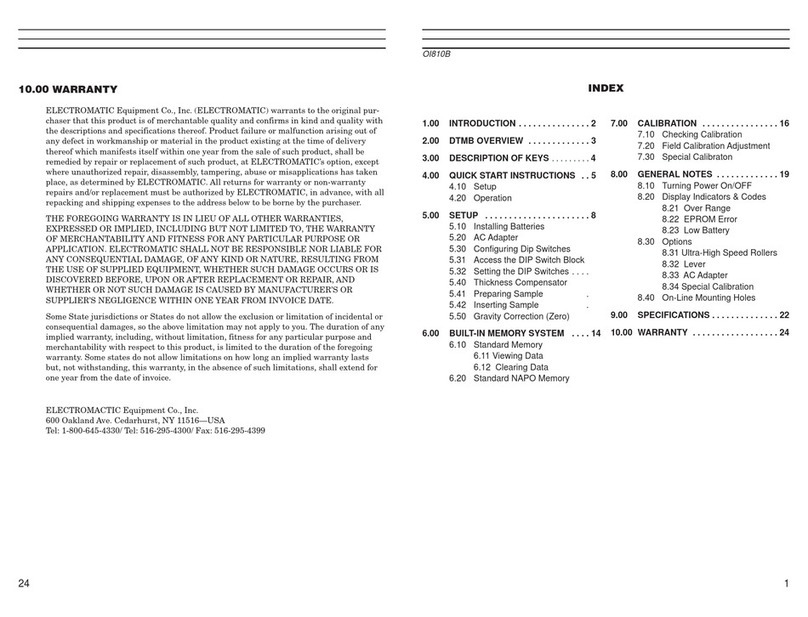
ELECTROMATIC
ELECTROMATIC CHECK LINE DTMB-200 User manual

ELECTROMATIC
ELECTROMATIC FS2 User manual

ELECTROMATIC
ELECTROMATIC STM-50 User manual
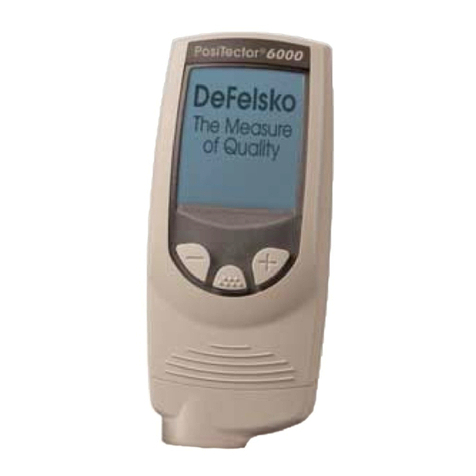
ELECTROMATIC
ELECTROMATIC PosiTector 6000 User manual
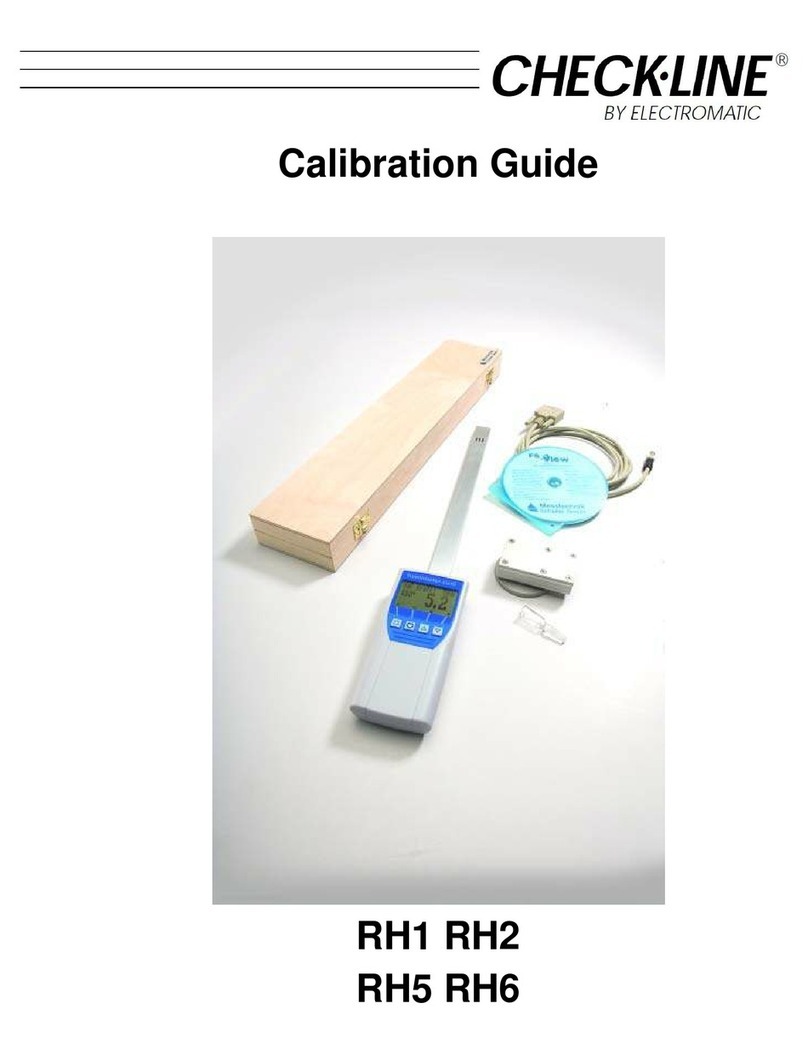
ELECTROMATIC
ELECTROMATIC Check-Line RH1 Use and care manual

ELECTROMATIC
ELECTROMATIC CHECK-LINE MTG User manual

ELECTROMATIC
ELECTROMATIC TI-007DL User manual
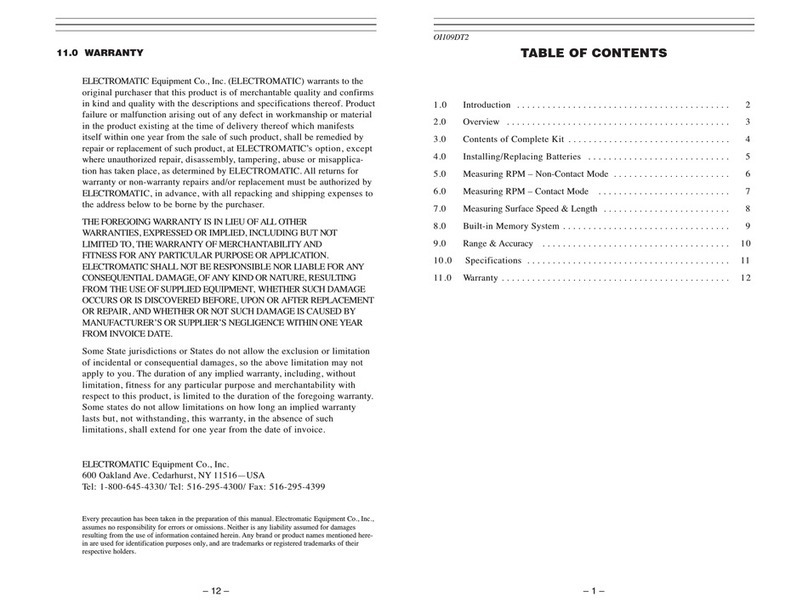
ELECTROMATIC
ELECTROMATIC Check-line DT-205LR User manual
